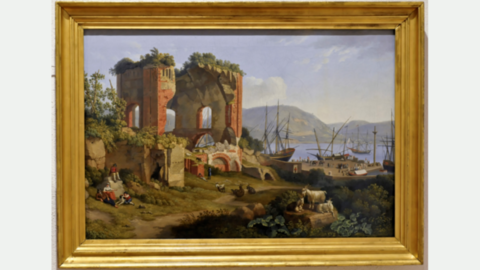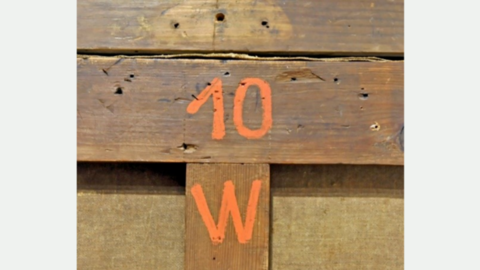The results of provenance research and insights into the history of the collection: Jakob Philipp Hackert’s painting “The Venus Temple in Baja” from the inventory of the Museum Wiesbaden.
Blog
On the occasion of the International Provenance Research Day 2023

The painting “The Venus Temple in Baja” by Jakob Philipp Hackert (1737-1807) has been part of the Museum Wiesbaden’s inventory since 1936. Research has been able to reconstruct almost seamlessly the provenance of the work, dated to 1798, thus excluding the possibility of its being expropriated as a result of National Socialist persecution. The painting’s origins can be traced back to the painter’s family. In addition, the object’s biography reveals numerous fascinating references to the history of this institution and its collection, even beyond the National Socialist era.
Jakob Philipp Hackert was one of the few German-speaking landscape painters of his time of European standing. After an apprenticeship in Berlin and sojourns in Sweden and, in particular, France, he worked for most of his life in Italy. Here he established himself as an internationally much sought after artist, who up into the 19th century shaped the popular image of the Mediterranean landscape. He was initially active in Rome starting in 1769; then from 1786 onwards he worked as court painter for King Ferdinand IV. Visits from travellers to Italy from all over the world, to include German artists and members of the English nobility, as well as commissions from royalty, for instance the family of the Russian Czar, increased his fame and made his works known throughout Europe. Finally, a comprehensive biography published by Goethe in 1811 established Hackert’s reputation as one of the 18th century’s outstanding landscape painters.
The painting shows the ruins of the so-called Venus Temple of Baja (formerly Baiae), a city on the Campanian coast west of Pozzuoli famous for its thermal baths dating from Hadrian’s time. To the right the view opens up to reveal the Gulf of Pozzuoli and the busy harbour of Baiae. In the direct vicinity of the meticulously depicted ruins, several ramblers and a family of shepherds are resting. Scattered around the terrain are some goats, and in the right foreground a large stone bears the legend “Tempio di Venere a Baja Filippo Hackert dipinse 1798”.
A present to the Nassauischer Kunstverein
The landscape painting by Jakob Philipp Hackert was originally presented as a gift to the Nassauischer Kunstverein in 1937 by Emma Eichhorn (1871-1964) of Wiesbaden. Her husband Bruno Eichhorn (1864-1926) had inherited the painting from a cousin who was a descendent of Wilhelmine Behrendt, née Hackert (dates unknown), the artist’s youngest sister. Together with her husband the Berlin merchant and court councillor Friedrich Christian Behrendt (1765-1838), she was her brother’s principal heir.
Acquisition through exchange
Together with two further paintings, this painting was acquired for the Wiesbaden Art Gallery’s collection by means of a complex exchange deal with the Nassauischer Kunstverein. In return, the Kunstverein received the Wiesbaden Art Gallery’s entire “Neue Form” [New Form] collection. The latter consisted of some 60 modern arts and crafts objects from the Bauhaus milieu (works in textiles, wood, glass, metal, leather, and ceramics), and with the financial support of the Reich Minister of the Interior had been founded only a few years earlier—in 1929—by the then director of the Wiesbaden Art Gallery, Schenk zu Schweinsberg (1893-1990).
With the concurrence of the Wiesbaden city administration, the exchange was initiated by Hermann Voss (1884-1969), the director of the gallery since April 1935. Since work on this “Neue Form” collection “had been halted in 1933, in part for lack of funds, and in part because of fundamental reservations concerning such a tendentiously selected collection of modern handicrafts,” Voss suggested ceding its contents to the Nassauischer Kunstverein to use as prizes in its annual members’ tombola. In exchange, the Nassauischer Kunstverein ceded to the city administration as the Art Gallery’s funding agency three paintings in its possession, including the Italian landscape under consideration here.
Evacuation during the war
On 1 April 1943, Hermann Voss assumed the offices of “Special Envoy for the Führer Museum in Linz” and Director of the Dresden State Art Galleries, whereby he continued to direct the Wiesbaden Art Gallery in an honorary capacity, delegating his duties there to his research assistant Juliane Harms (1902-1966). At Hermann Voss’s instigation, starting in 1943 particularly valuable art works in the Wiesbaden Art Gallery, including the Hackert painting, were evacuated to the Dresden State Art Galleries’ depots to protect them from war damage—initially to Schloß Weesenstein and subsequently to Schloß Pillnitz. The paintings purchased by Hermann Voss for the Wiesbaden gallery after leaving Wiesbaden in 1943 and 1944 were also sent directly to Schloß Weesenstein.
Attempts at repatriation
Directly after the end of the war, the City of Wiesbaden and the Wiesbaden Art Gallery attempted to repatriate the evacuated collection, now located in the Soviet zone of occupation. As proof of the Wiesbaden Art Gallery’s right of ownership to the works, the Dresden State Art Galleries requested copies of the last inventory catalogue from 1937, as well as supplementary lists of the acquisitions made after 1939. The information contained therein formed the basis of a list prepared in Dresden of the pictures held there under the rubric “Depot Wiesbaden”. On their reverse, the paintings were accordingly each marked with a tangerine-coloured “W” for Wiesbaden, together with a serial number (see photograph of the reverse of the Hackert painting: “10 W”).

In the years that followed too, succeeding museum directors in the two cities communicated regularly on this set of works. Thus Clemens Weiler (1909-1982) was invited to Weimar in October of 1953 by the Lucas Cranach Committee and, at a conference of museum directors there, was able to bring up the subject of the Wiesbaden pictures to the director of the Dresden State Art Galleries, Gertrud Rudloff-Hille (1900-1983). In June of 1956, when he visited Dresden on the occasion of the city’s 750th anniversary, Weiler had a first opportunity of assuring himself that the Wiesbaden Art Gallery works were in good condition—in the meantime they had been moved to Schloss Pillnitz.
Attempts were being made in parallel on a political level to find a solution regarding the return of the pictures in the custody of the Dresden State Art Galleries. In May of 1986, the governments of the German Democratic Republic and the Federal Republic of Germany agreed in the so-called Cultural Convention to a mutual return of paintings evacuated during the Second World War. The agreement stipulated the return of a total of 290 works of art to the Darmstadt Palace Museum, the Wallraf-Richartz-Museum in Cologne, and the Museum Wiesbaden, in exchange for paintings being returned to museums in the GDR.
In August of 1988, 63 of the works previously evacuated to Dresden arrived at the Museum Wiesbaden, including Jakob Philipp Hackert’s “Venus Temple in Baja”. Together with other works from this group, from October 1992 to February 1993 it was for the first time in over 50 years exhibited in the Museum Wiesbaden again—in a special exhibition of “Paintings Returned from Dresden”. From 2013 to 2018, it formed part of the permanent exhibition in the landscape room of the Old Masters collection, housed in the museum’s renovated south wing.
Miriam Olivia Merz
Literature:
Official catalogue of the Wiesbaden Art Gallery, Wiesbaden, 1937.
Official catalogue of the Wiesbaden Art Gallery, supplement, Wiesbaden, 1939.
Goldkuhle, Fritz: Die Ruine des ’Venustempels von Baiae‘ als Bildmotiv in der Kunst des 17. und 18. Jahrhunderts [the ruins of the ‘Venus Temple in Baiae’ as image motif in the art of the 17th and 18th centuries], in: Bonner Jahrbücher 159, 1959, pp. 272-280.
Claudia Nordhoff, Jakob Philipp Hackert, 1737-1807. Verzeichnis seiner Werke [Jakob Philipp Hackert, 1737-1807: inventory of his works], Berlin 1994.